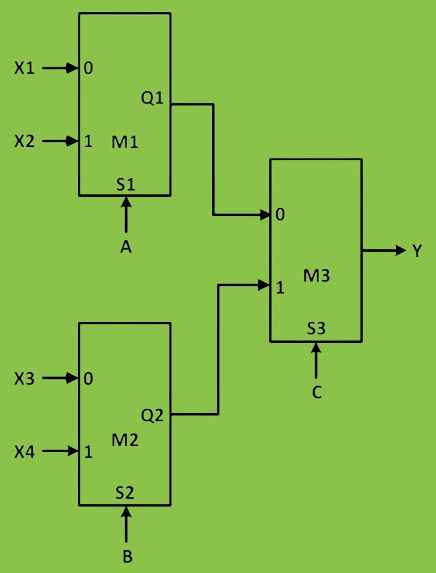SYLLABUS
Boolean algebra. Combinational and sequential circuits. Minimization. Number representations and computer arithmetic (fixed and floating point).
Q1 – Consider a system that uses 5 bits for representing signed integers in 2’s complement format. In this system, two integers 𝐴 and 𝐵 are represented as 𝐴=01010 and 𝐵=11010.
Which one of the following operations will result in either an arithmetic overflow or an arithmetic underflow?
(A) 𝐴+𝐵
(B) 𝐴−𝐵
(C) 𝐵−𝐴
(D) 2∗𝐵
Ans – (B)
Explanation – In a 5-bit two’s complement numbers can range from -16 to 15 where the leftmost bit is the sign bit (0 means positive, 1 means negative).
Given the two numbers: A = 01010 and B = 11010, we want to first convert these to decimal.
Since A starts with a 0, it is positive, and therefore its decimal number is 10, then for B which starts with a 1 (indicating a negative number), we will convert it to 2’s complement.
To do this, we will invert the bits (1’s complement) and then add 1, therefore, B = -6 after conversion.
Now, we will evaluate whether each operation has an arithmetic overflow or underflow. The option (A) addition of A + B = 10 + (-6) = 4, which is within range (-16 to 15), therefore will not cause overflow.
The option (B), subtraction A – B = 10 – (-6) = 16, is NOT within range and exceeds the maximum representable value (15) in 5-bit two’s complement, thus it will cause an overflow.
The subtraction B – A = -6 – 10 = -16, is NOT an underflow because -16 is within range.
The multiplication B x 2 = 2 x (-6) = -12, is also valid. Therefore, only A – B caused an overflow, thus the correct answer is (B).
Q2 – Consider the circuit shown below where the gates may have propagation delays. Assume that all signal transitions occur instantaneously and that wires have no delays.
Which of the following statements about the circuit is/are CORRECT?
(A) With no propagation delays, the output 𝒀 is always logic Zero
(B) With no propagation delays, the output 𝒀 is always logic One
(C) With propagation delays, the output 𝒀 can have a transient logic One after 𝑿 transitions from logic Zero to logic One
(D) With propagation delays, the output 𝒀 can have a transient logic Zero after 𝑿 transitions from logic One to logic Zero
Ans – (A, C)
Explanation – The output Y is represented by the expression Y = X⋅X’
The expression always evaluates to 0 because anything AND its complement will always be zero.
In the case with no propagation delays
The NOT gate will give the complement of X immediately, then the AND gate computes X⋅X’, which will yield 0.
Thus, option A is correct.
In the case with propagation delays
In a real circuit, there may be a small and finite time for a gate to respond out to its output. If you were to make X transition from 0 to 1, the inverter (the NOT gate) may not transition to 0 at exactly the same time. At that moment (very short), both inputs to the AND gate are both 1, in this case there will be an output Y of 1, which may eventually will settle to 0. A transient output Y as we see occurs with a glitch.
Meaning the output somehow happened for a very short moment, as you would blink rather quickly, thus, option C is correct.
Q3 – Consider a Boolean expression given by 𝐹(𝑋,𝑌,𝑍)=Σ(3,5,6,7)
Which of the following statements is/are CORRECT?
(A) 𝐹(𝑋,𝑌,𝑍) = Π(0,1,2,4)
(B) 𝐹(𝑋,𝑌,𝑍) = 𝑋𝑌+𝑌𝑍+𝑋𝑍
(C) 𝐹(𝑋,𝑌,𝑍) is independent of input 𝑌
(D) 𝐹(𝑋,𝑌,𝑍) is independent of input 𝑋
Ans – (A, B)
Explanation –

F(X, Y, Z) = XY + YZ + XZ. Hence option (B) is correct.
F(X, Y, Z) = Σ(3, 5, 6, 7). This indicates that the function is a 1 for the min-terms 3,5,6,7. The min-terms not in F are 0, 1, 2, and 4. This means those are maxterms. So, the product-of-maxterms is Π(0,1,2,4) which is the correct dual representation. So, option (A) is correct.
Q4 – Consider a digital logic circuit consisting of three 2-to-1 multiplexers M1, M2, and M3 as shown below. X1 and X2 are inputs of M1. X3 and X4 are inputs of M2.
A, B, and C are select lines of M1, M2, and M3, respectively.

For an instance of inputs X1=1, X2=1, X3=0, and X4=0, the number of combinations of A, B, C that give the output Y=1 is _________.
Ans – (4)
Explanation –
We are given, X1 = 1 and X2 = 2, So it does not matter if A is 0 or 1.
Also, X3 = 0 and X4 = 0, So, it does not matter if B is 0 or 1.
Now, we are given that output Y = 1. So, C must be 0 because
The equation is, Y = C’.Q1 + C.Q2 = 1.1 + 0.0 = 1
A | B | C | Y |
0 | 0 | 0 | 1 |
0 | 1 | 0 | 1 |
1 | 0 | 0 | 1 |
1 | 1 | 0 | 1 |
So, 4 combinations are there.




